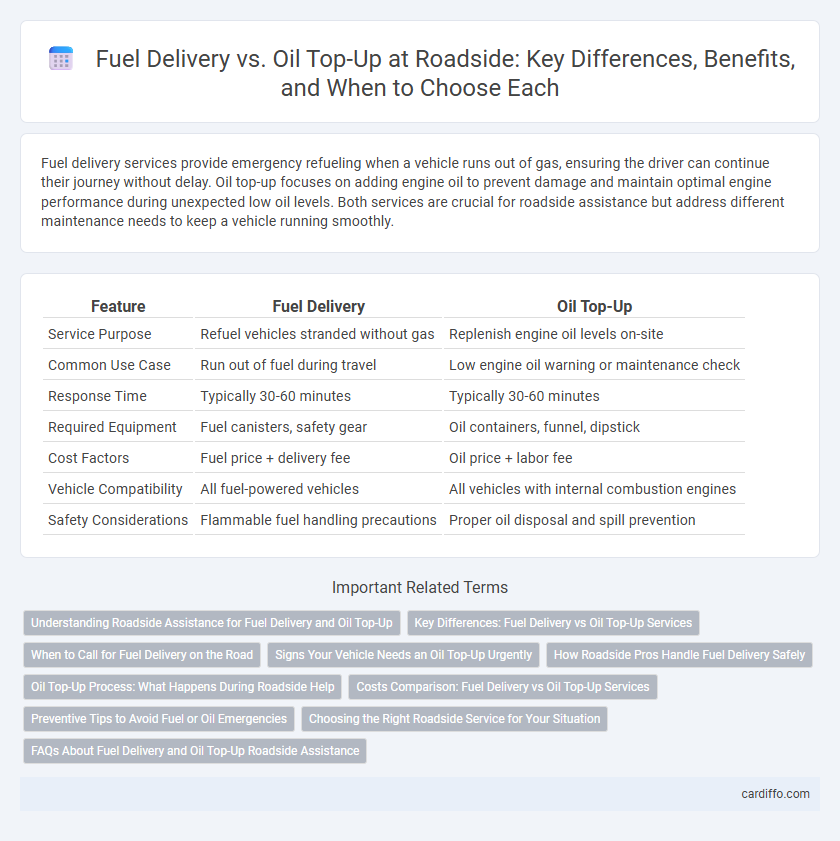Fuel delivery services provide emergency refueling when a vehicle runs out of gas, ensuring the driver can continue their journey without delay. Oil top-up focuses on adding engine oil to prevent damage and maintain optimal engine performance during unexpected low oil levels. Both services are crucial for roadside assistance but address different maintenance needs to keep a vehicle running smoothly.
Table of Comparison
| Feature | Fuel Delivery | Oil Top-Up |
|---|---|---|
| Service Purpose | Refuel vehicles stranded without gas | Replenish engine oil levels on-site |
| Common Use Case | Run out of fuel during travel | Low engine oil warning or maintenance check |
| Response Time | Typically 30-60 minutes | Typically 30-60 minutes |
| Required Equipment | Fuel canisters, safety gear | Oil containers, funnel, dipstick |
| Cost Factors | Fuel price + delivery fee | Oil price + labor fee |
| Vehicle Compatibility | All fuel-powered vehicles | All vehicles with internal combustion engines |
| Safety Considerations | Flammable fuel handling precautions | Proper oil disposal and spill prevention |
Understanding Roadside Assistance for Fuel Delivery and Oil Top-Up
Roadside assistance for fuel delivery ensures drivers receive emergency gasoline or diesel directly at the breakdown location, preventing the hassle of walking to a gas station. Oil top-up services focus on replenishing engine oil levels to maintain optimal engine performance and avoid potential damage during long trips. Both services provide critical support during unexpected vehicle maintenance needs, enhancing safety and minimizing roadside delays.
Key Differences: Fuel Delivery vs Oil Top-Up Services
Fuel delivery services provide drivers with essential fuel, such as gasoline or diesel, directly to their vehicle at the roadside, preventing stoppage due to an empty tank. Oil top-up services, on the other hand, focus on replenishing engine oil levels to maintain engine performance and prevent damage. While fuel delivery addresses immediate mobility needs, oil top-up is a preventative maintenance step critical for vehicle longevity.
When to Call for Fuel Delivery on the Road
Calling for fuel delivery on the road is essential when your vehicle runs out of gas unexpectedly, preventing you from reaching the nearest station safely. Fuel delivery services provide timely assistance by bringing the exact fuel type directly to your location, minimizing delays and potential hazards. Unlike an oil top-up, which maintains engine health during routine maintenance, fuel delivery addresses immediate fuel depletion emergencies during travel.
Signs Your Vehicle Needs an Oil Top-Up Urgently
Low engine oil levels trigger warning lights on the dashboard and cause unusual engine noises, signaling an urgent need for an oil top-up to avoid severe damage. Symptoms like increased engine temperature, smoke from the exhaust, or reduced fuel efficiency also indicate critical oil depletion. Immediate oil top-up helps maintain engine lubrication, prevents overheating, and ensures optimal vehicle performance.
How Roadside Pros Handle Fuel Delivery Safely
Roadside professionals prioritize safety when handling fuel delivery by using specially designed containers that prevent spills and reduce fire hazards. They conduct thorough site assessments to identify safe entry points and maintain proper ventilation throughout the process. Trained technicians follow strict protocols, including grounding equipment to avoid static discharge, ensuring fuel is delivered efficiently and securely to stranded vehicles.
Oil Top-Up Process: What Happens During Roadside Help
During an oil top-up roadside service, a technician assesses the vehicle's oil level using the dipstick to determine if a refill is necessary. They then add the appropriate grade of engine oil directly into the oil filler cap, ensuring the level reaches the optimal mark without overfilling. This process helps prevent engine wear and maintains vehicle performance until a full oil change can be performed.
Costs Comparison: Fuel Delivery vs Oil Top-Up Services
Fuel delivery services generally incur higher costs due to the price of fuel, transportation, and emergency response convenience, while oil top-up services are typically more affordable, involving only the cost of oil and minor service fees. On average, fuel delivery can range from $50 to $100 depending on location and fuel type, whereas oil top-ups cost between $20 and $40 for standard oil grades. Choosing between fuel delivery and oil top-up depends on immediate vehicle needs and budget, with oil top-ups representing cost-effective maintenance compared to the higher expense of emergency fuel replenishment.
Preventive Tips to Avoid Fuel or Oil Emergencies
Regularly checking fuel levels and monitoring oil quality can prevent unexpected breakdowns during travel. Keeping an emergency fuel container and using high-quality engine oil reduce the risk of fuel shortages and engine damage. Scheduling routine maintenance and timely oil top-ups ensure optimal vehicle performance and minimize roadside emergencies.
Choosing the Right Roadside Service for Your Situation
Fuel delivery provides a critical solution when your vehicle runs out of gasoline or diesel, ensuring you can reach the nearest station without towing. Oil top-up addresses engine maintenance by replenishing essential fluids to prevent damage and maintain performance during unexpected oil drops. Choosing the right roadside service depends on the immediate need: fuel delivery for running out of gas and oil top-up for engine health preservation.
FAQs About Fuel Delivery and Oil Top-Up Roadside Assistance
Fuel delivery roadside assistance provides emergency refueling services when a vehicle runs out of gas, ensuring quick restoration of mobility without needing to tow the car. Oil top-up roadside assistance offers urgent engine oil refills to prevent engine damage and maintain optimal vehicle performance during critical moments on the road. Common FAQs include response time, cost differences, and vehicle eligibility for both fuel delivery and oil top-up services.
Fuel Delivery vs Oil Top-Up Infographic

 cardiffo.com
cardiffo.com